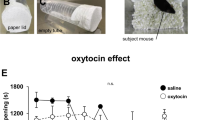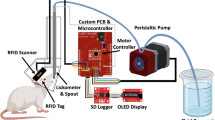Abstract
Hoarding is a species-typical behavior shown by rodents, as well as other animals. By hoarding, the rodent secures a food supply for times of emergency (for example, when threatened by a predator) or for times of seasonal adversity such as winter. Scatter hoarding, as seen typically in squirrels and birds, involves placing small caches of food in hidden places, generally underground. Most rodents, however, hoard a supply of food in or near the home base — for example, in 'larders' near the sleeping quarters in a burrow. In the laboratory, measurement of hoarding involves simply weighing the food transported into the home cage from an external source, but the route to that source must be secure and animal-proof; for example, there should be no holes large enough to permit escape of a mouse, and no weak points that could be enlarged by gnawing. A suitable and easily constructed apparatus is described in the protocol. Hoarding has been shown to be sensitive to brain lesions and pharmacological agents, and is a suitable test for species-typical behavior in genetically modified mice.
This is a preview of subscription content, access via your institution
Access options
Subscribe to this journal
Receive 12 print issues and online access
$259.00 per year
only $21.58 per issue
Buy this article
- Purchase on Springer Link
- Instant access to full article PDF
Prices may be subject to local taxes which are calculated during checkout

Similar content being viewed by others
References
Malakoff, D. The rise of the mouse, biomedicine's model mammal. Science 288, 248–253 (2000).
Fantino, M. & Cabanac, M. Effect of a cold ambient temperature on the rat's food hoarding behavior. Physiol. Behav. 32, 183–190 (1984).
Damecour, C.L. & Charron, M. Hoarding: a symptom, not a syndrome. J. Clin. Psychiatry 59, 267–272 (1998).
Greenberg, D., Witztum, E. & Levy, A. Hoarding as a psychiatric symptom. J. Clin. Psychiatry 51, 417–421 (1990).
Barnett, S.A. The Rat: a Study in Behavior 2nd edition (University of Chicago Press, Chicago, Illinois, 1975).
Kays, R.W. & Wilson, D.E. Mammals of North America (Princeton University Press, Princeton, New Jersey, 2002).
Wolfe, J.B. An exploratory study of food storing in rats. J. Comp. Psychol. 28, 97–101 (1939).
Fuster, J. The Prefrontal Cortex 3rd edition 209–252 (Lippincott–Raven, Philadelphia, Philadelphia, 1997).
Thierry, A.M., Gioanni., Y., Degenetais, E. & Glowinski, J. Hippocampo-prefrontal cortex pathway: anatomical and electrophysiological characteristics. Hippocampus 10, 411–419 (2000).
Deacon, R.M.J., Croucher, A. & Rawlins, J.N.P. Hippocampal cytotoxic lesion effects on species-typical behaviors in mice. Behav. Brain Res. 132, 203–213 (2002).
Deacon, R.M.J., Penny, C. & Rawlins, J.N.P. Effects of medial prefrontal cortex cytotoxic lesions in mice. Behav. Brain Res. 139, 139–155 (2003).
Kolb, B. Prefrontal lesions alter eating and hoarding behaviour in rats. Physiol. Behav. 12, 507–511 (1974).
Lacroix, L., Broersen, L.M., Weiner, I. & Feldon, J. The effects of excitotoxic lesion of the medial prefrontal cortex on latent inhibition, prepulse inhibition, food hoarding, elevated plus maze, active avoidance and locomotor activity in the rat. Neuroscience 84, 431–442 (1998).
Kelley, A.E. & Stinus, L. Disappearance of hoarding behavior after 6-hydroxydopamine lesions of the mesolimbic dopamine neurons and its reinstatement with l-dopa. Behav. Neurosci. 99, 531–545 (1985).
Stam, C.J., de Bruin, J.P., van Haelst, A.M., van der Gugten, J. & Kalsbeek, A. Influence of the mesocortical dopaminergic system on activity, food hoarding, social-agonistic behavior, and spatial delayed alternation in male rats. Behav. Neurosci. 103, 24–35 (1989).
Mogenson, G.J. & Wu, M. Disruption of food hoarding by injections of procaine into mediodorsal thalamus, GABA into subpallidal region and haloperidol into accumbens. Brain Res. Bull. 20, 247–251 (1988).
Stein, D.J., Laszlo, B., Marais, E., Seedat, S. & Potocnik, F. Hoarding symptoms in patients on a geriatric psychiatry inpatient unit. S. Afr. Med. J. 87, 1138–1140 (1997).
Beigneux, F., Lasalle, J.M. & Le-Pape, G. Hoarding behavior of AKR, C57BL/6 mice and their F1 in their home living space: an automatic recording technique. Physiol. Behav. 24, 1191–1193 (1980).
Manosevitz, M., Campenot, R.B. & Swencionis, C.F. Effects of enriched environment upon hoarding. J. Comp. Physiol. Psychol. 66, 319–324 (1968).
Whishaw, I.Q., Oddie, S.D., McNamara, R.K., Harris, T.L. & Perry, B.S. Psychophysical methods for study of sensory-motor behavior using a food-carrying (hoarding) task in rodents. J. Neurosci Meth. 32, 123–133 (1990).
Acknowledgements
This work was supported by grant GR065438MA from the Wellcome Trust to the Oxford OXION group.
Author information
Authors and Affiliations
Corresponding author
Ethics declarations
Competing interests
The author declares no competing financial interests.
Rights and permissions
About this article
Cite this article
Deacon, R. Assessing hoarding in mice. Nat Protoc 1, 2828–2830 (2006). https://doi.org/10.1038/nprot.2006.171
Published:
Issue Date:
DOI: https://doi.org/10.1038/nprot.2006.171
This article is cited by
-
An effort toward molecular biology of food deprivation induced food hoarding in gonadectomized NMRI mouse model: focus on neural oxidative status
BMC Neuroscience (2018)
-
An effort toward molecular neuroeconomics of food deprivation induced food hoarding in mice: focus on xanthine oxidoreductase gene expression and xanthine oxidase activity
Metabolic Brain Disease (2018)
-
Late prenatal immune activation causes hippocampal deficits in the absence of persistent inflammation across aging
Journal of Neuroinflammation (2015)
Comments
By submitting a comment you agree to abide by our Terms and Community Guidelines. If you find something abusive or that does not comply with our terms or guidelines please flag it as inappropriate.



